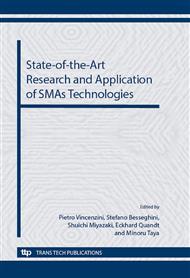p.69
p.75
p.81
p.87
p.92
p.103
p.113
p.119
p.125
Design of a Solid State Shape-Memory-Actuator with Guidance Functionality
Abstract:
Machine tools for small work pieces are characterized by an extensive disproportion between workspace and cross section. This is mainly caused by limitations in the miniaturization of drives and guidance elements. Due to their high specific workloads and relatively small spatial requirements, Thermal Shape-Memory-Alloys (SMA) possess an outstanding potential to serve as miniaturized drives in small machines. However, most of the known SMA drive applications necessitate additional guidance elements to realize a certain mechanical stiffness. In this paper we present a novel SMA actuator design, which does rather not require an additional guidance. The stiffness in directions different from the actuators moving direction is realized by a specific arrangement of the SMA elements. Those are designed regarding geometry, applied load, and control aspects. Furthermore, a sample actuator is built to investigate the capabilities to serve as miniaturized feed axis in small machines.
Info:
Periodical:
Pages:
113-118
Citation:
Online since:
September 2012
Authors:
Price:
Сopyright:
© 2013 Trans Tech Publications Ltd. All Rights Reserved
Share:
Citation:


